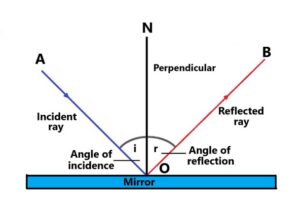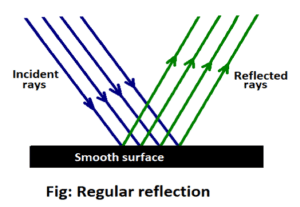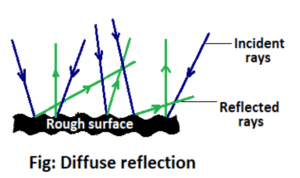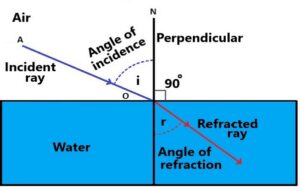
Introduction
Light is a type of energy that enters the eye and causes the reflection of the object in the retina. The human brain creates the sensation of an object similar to the object. This article defines a detail for the reflection vs refraction of light and their definition and differences.
Objects that emit light by themselves are called sources of light. There are two types of light sources a type of source of light that radiates its own light, is called a self-luminous source. Such as the sun, burning candles, electric bulbs, etc. Light sources or objects that have no light of their own, reflect and illuminate the light from the luminous object, are called non-luminous sources.
Most of the objects that people see around them are non-luminous objects. The moon and the planets are non-luminous. With the help of this light, all living creatures can see. There are many properties of light. One of these properties of light is the reflection and refraction of light (1) & (4).
Reflection of light

When light passes through a transparent medium, it is obstructed by another medium. Then some amount of light from the differential surface of the two mediums comes back through the previous medium, this phenomenon is called reflection of light (2).
Example
One of the examples of the reflection of light is when we stand in front of a plane mirror we see our reflection. The image is created for the reflection of light in the mirror (1).
Law of reflection of light
The reflection of light occurs depending on two formulas
- The incident ray, the reflected ray, and the perpendicular drawn to the reflector at the point of incidence are on the same plane.
- The angle of incidence is always equal to the angle of reflection (1).
Type of reflection of light
There are two types of light reflection according to the nature of the reflector surface.
1. Regular reflection

When a bunch of parallel light rays falls on a smooth surface, those rays are reflected according to certain rules. And the reflected rays move in a certain direction in parallel. This kind of reflection of light is called regular reflection (1).
Example
The reflection of the sun’s rays in a plane mirror is an example of regular reflection. In this case, the angle of incidence of each ray of light is equal and the angle of reflection is also equal (4).
Regular reflection is formed of the object’s reflection. The reflection in the mirror and the reflection of the tree in the still water of the pond are produced by the regular reflection of light rays. In regular reflection, the reflected rays go in a certain direction, so the reflector looks black when viewed from any other direction (1).
2. Diffuse reflection

When a bunch of parallel light rays falls on a rough surface, even if each ray of that bundle of rays follows the rules of reflection, the reflected rays do not go in a certain direction in a parallel way. Scattered all around. Such a reflection of light rays is called diffuse reflection (4).
Example
Rubbed glass, walls of the house, white paper, floor of the house, tables, chairs, cinema screen, etc. are opaque and rough. So from these reflectors, there is a diffuse reflection of light (4).
In diffuse reflection, the incident rays are reflected in different directions. So the object looks equally bright when viewed from any angle. Diffuse reflections do not form the reflection of objects. This is because the rays reflected in the diffuse reflection scatter around. They do not meet at a single point or seem to be moving away from a point. Different objects can be seen for diffuse reflection. Different objects are seen for diffuse reflection.
After sunset, the earth’s surface is illuminated for a while. It is called twilight. Before the sunrise, the earth’s surface is also illuminated. It is called dawn. The natural phenomena of twilight and dawn are caused by the diffuse reflection of the sun’s rays from the numerous dust particles floating in the sky (1).
Refraction of light

In the transparent medium, the ray of light passes in a straight line. The speed of light is different in different types of mediums.
As a result, when a ray of light passes through one medium and enters another, it falls diagonally on the differential surface of the two mediums.
And changes in the direction of motion of the light at the differential surface. This phenomenon is called the refraction of light (3).
Law of refraction of light
The refraction of light follows two formulas.
- The incident ray, the reflected ray, and the perpendicular drawn on the refracting plane, at the point of incidence are always on the same plane.
- The ratio of the sin of the angle of incidence and the sin of the angle of refraction is constant (µ) in the case of two specific mediums and two specific colors of light. Scientist Snell discovered the second law of refraction. So according to his name, this law is called Snell’s law (4).
Natural phenomena caused by refraction
1. The sun is seen for a while before sunrise and after sunset
This is because the density of air levels above the surface is lower. So the rays coming from the sun are constantly refracted from the light-medium to the dense medium. And the rays reflected in each level move towards the perpendicular.
As a result, even though the sun is below the horizon line, the rays coming from the sun gradually enter through the dense layer and fall into the eyes of the viewer. The viewer’s eyes cannot follow the curved direction of the sun rays so the viewer sees the rays directly. As a result, the apparent position of the sun is slightly higher than the actual position of the sun. This is why the sun can be seen just above the horizon line (1).
2. The twinkling of stars
This is because of the different densities of the various layers of the atmosphere above the earth. Moreover, the temperature changes constantly and is not the same everywhere. As a result, the density and refractive index of the air layers change.
The stars are far away from the Earth and have their own light. The rays coming from the stars come through different density layers of the atmosphere before reaching the earth.
As the density and refractive index of the air levels change, the direction of the rays changes as they pass through these levels. Due to this, sometimes less or more light reaches the eyes of the viewer. As a result, the brightness of the star decreases and increases. So it is thought that the stars are twinkling (5).
Description of the change in direction of rays due to refraction
- When a ray enters from light-medium to dense medium (from air to glass or water), the refracted ray moves towards the perpendicular.
- The ray enters from the dense medium to a light-medium (from glass or water to air), and the refracted ray moves away from the perpendicular.
- When a ray falls vertically from a light-medium to a dense medium or from a dense medium to a light medium, that ray enters the second medium directly without changing direction (1).
Difference between reflection and refraction of light
There are some differences between reflection and refraction of light. It is discussed with the help of a table below.
Content |
Reflection |
Refraction |
1. Definition |
When a ray of light falls on a smooth surface or a flat mirror, those rays are reflected according to certain rules and the reflected rays go in a certain direction in parallel.
This phenomenon is the reflection of light (1). |
When a ray enters diagonally from one medium to another, the direction of that ray changes in the differential surface of the two mediums.
This phenomenon is called the refraction of light (1). |
2. Light direction |
In this process, the direction of light does not change. The rays go in a certain direction in parallel after being reflected. | In this process, the direction of light is changed. |
3. Type of light enter |
In reflection, the light ray does not enter any medium. Here the bunch of light rays falls parallel to the smooth surface. | In refraction, a bunch of light rays enters diagonally from one medium to another. |
4. Type |
There are two types of reflection of light according to the nature of the reflector surface. These are regular reflection and diffuse reflection. | There is no type of refraction of light. |
5. Surface type |
This process occurs on a shiny surface. | The process of refraction of light occurs on a transparent surface. |
6. Angle type |
The angle of incidence is always equal to the angle of reflection in the process of reflection. | In this process, the value of the angle of incidence is not equal to the value of the angle of reflection. |
7. Medium |
The rays of reflection do not pass through any medium. So this process does not need any medium. | This process requires two mediums. |
8. Place of Creation |
The process of reflection of light is created in a smooth mirror. | On the other hand, the process of refraction of light occurs in the concave and convex lenses (1) & (4). |
